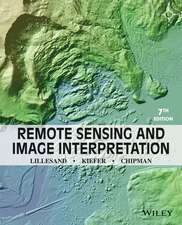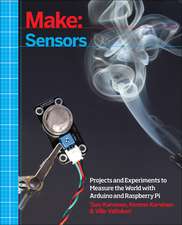Handbook of Signal Processing Systems
Editat de Shuvra S. Bhattacharyya, Ed F. Deprettere, Rainer Leupers, Jarmo Takalaen Limba Engleză Paperback – 3 mai 2017
This handbook is an essential tool for professionals in many fields and researchers of all levels.
| Toate formatele și edițiile | Preț | Express |
|---|---|---|
| Paperback (2) | 1281.25 lei 39-44 zile | |
| Springer – 3 mai 2017 | 1281.25 lei 39-44 zile | |
| Springer International Publishing – 23 feb 2019 | 1626.48 lei 39-44 zile | |
| Hardback (2) | 1254.68 lei 6-8 săpt. | +74.33 lei 6-12 zile |
| Springer International Publishing – 22 oct 2018 | 1759.77 lei 3-5 săpt. | +74.33 lei 6-12 zile |
| Springer Us – sep 2010 | 1254.68 lei 6-8 săpt. |
Preț: 1281.25 lei
Preț vechi: 1663.97 lei
-23% Nou
Puncte Express: 1922
Preț estimativ în valută:
245.17€ • 267.14$ • 206.59£
245.17€ • 267.14$ • 206.59£
Carte tipărită la comandă
Livrare economică 21-26 aprilie
Preluare comenzi: 021 569.72.76
Specificații
ISBN-13: 9781493943005
ISBN-10: 1493943006
Pagini: 1399
Ilustrații: XXI, 1399 p. 708 illus. In 2 volumes, not available separately.
Dimensiuni: 155 x 235 mm
Greutate: 0 kg
Ediția:Softcover reprint of the original 2nd ed. 2013
Editura: Springer
Colecția Springer
Locul publicării:New York, NY, United States
ISBN-10: 1493943006
Pagini: 1399
Ilustrații: XXI, 1399 p. 708 illus. In 2 volumes, not available separately.
Dimensiuni: 155 x 235 mm
Greutate: 0 kg
Ediția:Softcover reprint of the original 2nd ed. 2013
Editura: Springer
Colecția Springer
Locul publicării:New York, NY, United States
Cuprins
Part I: Applications.- Signal Processing for Stereoscopic and Multiview 3D Displays.- Video Compression.- Inertial Sensors and their Applications.- Finding it Now: Construction and Configuration of Networked Classifiers in Real-Time Stream Mining Systems.- High-Energy Physics.- Signal Processing for Wireless Transceivers.- Signal Processing for Cryptography and Security Applications.- Digital Signal Processing in Home Entertainment.- Signal Processing for Control.- MPEG Reconfigurable Video Coding.- Signal Processing for High-Speed Links.- Medical Image Processing.- Low-power Wireless Sensor Network Platforms.- Signal Processing Tools for Radio Astronomy.- Distributed Smart Cameras and Distributed Computer Vision.- Part II: Architectures.- Architectures for Stereo Vision.- Multicore Systems on Chip.- Coarse-Grained Reconfigurable Array Architectures.- Arithmetic.- Architectures for Particle Filtering.- Application Specific Instruction Set DSP Processors.- FPGA-Based DSP.- Application Specific Accelerators for Communications.- General-Purpose DSP Processors.- Mixed Signal Techniques.- DSP Systems using Three-Dimensional Integration Technology.- Part III: Design Methods and Tools.- Methods and Tools for Mapping Process Networks onto Multi-Processor Systems-On-Chip.- Dynamic Dataflow Graphs.- DSP Instruction Set Simulation.- Integrated Modeling using Finite State Machines and Dataflow Graphs.- C Compilers and Code Optimization.- Kahn Process Networks and a Reactive Extension.- Decidable Dataflow Models for Signal Processing.- Systolic Arrays.- Multidimensional Dataflow Graphs.- Compiling for VLIW DSPs.- Software Compilation Techniques for MPSoCs.- Embedded C for Digital Signal Processing.- Signal Flow Graphs and Data Flow Graphs.- Optimization of Number Representations.- Polyhedral Process Networks.- Mapping Decidable Signal Processing Graphs into FPGA Implementations.
Recenzii
From the reviews of the second edition:
“This two-volume handbook is a monumental collection of 42 papers dealing with specific aspects of the design, analysis, and implementation of systems using digital signal processing. … This handbook can be used by researchers as a comprehensive reference, or by teachers offering specialized papers to their students.” (L.-F. Pau, Computing Reviews, February, 2014)
“This two-volume handbook is a monumental collection of 42 papers dealing with specific aspects of the design, analysis, and implementation of systems using digital signal processing. … This handbook can be used by researchers as a comprehensive reference, or by teachers offering specialized papers to their students.” (L.-F. Pau, Computing Reviews, February, 2014)
Caracteristici
The Handbook of Signal Processing Systems provides definitive information on signal processing systems from highly regarded researchers
The style of the entries in the handbook is expository and tutorial, making the book a practical resource for signal-processing experts as well as professionals in other fields who need to access this vital information but may not have the time to work their way through an entire text on their topic of interest
New to this edition are contributions on inertial sensors, real-time stream mining, stereoscopic and multiview 3D displays, wireless transceivers, radio astronomy, stereo vision, particle ?ltering architectures, and multidimensional data?ow graphs
New chapters on architectures and design methods
Extensive and updated bibliography for further reading
Serves as a suitable first point of entry to the field for students and professionals alike
The style of the entries in the handbook is expository and tutorial, making the book a practical resource for signal-processing experts as well as professionals in other fields who need to access this vital information but may not have the time to work their way through an entire text on their topic of interest
New to this edition are contributions on inertial sensors, real-time stream mining, stereoscopic and multiview 3D displays, wireless transceivers, radio astronomy, stereo vision, particle ?ltering architectures, and multidimensional data?ow graphs
New chapters on architectures and design methods
Extensive and updated bibliography for further reading
Serves as a suitable first point of entry to the field for students and professionals alike
Notă biografică
Shuvra S. Bhattacharyya is a Professor in the Department of Electrical and Computer Engineering at the University of Maryland, College Park. He holds a joint appointment in the University of Maryland Institute for Advanced Computer Studies (UMIACS). From January 2015 through December 2018, he is also a part-time visiting professor in the Department of Pervasive Computing at the Tampere University of Technology, Finland, as part of the Finland Distinguished Professor Programme (FiDiPro). His research interests include signal processing, embedded systems, electronic design automation, wireless communication, and wireless sensor networks. He received the B.S. degree from the University of Wisconsin at Madison, and the Ph.D. degree from the University of California at Berkeley. He has held industrial positions as a Researcher at the Hitachi America Semiconductor Research Laboratory (San Jose, California), and Compiler Developer at Kuck & Associates (Champaign, Illinois). He has held a visiting research position at the US Air Force Research Laboratory (Rome, New York). He has been a Nokia Distinguished Lecturer (Finland) and Fulbright Specialist (Austria and Germany). He has received the NSF Career Award (USA). He is a Fellow of the IEEE.
Ed F. Deprettere received the M.Sc degree in Electrical Engineering from Ghent University (Belgium) in 1968, and the Ph.D. degree in Electrical Engineering from Delft University of Technology (The Netherlands) in 1980. At Delft he has held visiting research positions at Stanford University, University of California at Los Angeles, and Philips Research. In 2000 he joined Leiden University as full professor in the Leiden Institute of Advanced Computer Science, where he has been head of the Leiden Embedded Research Center. While in Leiden, he held visiting professor positions at the Indian Institute of Science (Bangalore, India), and the Technical University of Sofia (Bulgaria). He was founder of the Daedalus foundation which was to coordinate the co-operation with Sofia. Ed F. Deprettere is now emeritus professor since 2012.
Rainer Leupers received the M.Sc. (Dipl.-Inform.) and Ph.D. (Dr. rer. nat.) degrees in Computer Science with honors from TU Dortmund in 1992 and 1997. From 1997-2001 he was the chief engineer at the Embedded Systems chair at TUDortmund. In 2002, Dr. Leupers joined RWTH Aachen University as a professor for Software for Systems on Silicon. Since then, he has also been a visiting faculty member at the ALARI Institute in Lugano. His research and teaching activities comprise software development tools, processor architectures, and system-level electronic design automation, with focus on application-specific multicore systems. He published numerous books and technical papers, and heserved in committees of leading international conferences, including DAC, DATE, and ICCAD. He was a co-chair of the MPSoC Forum and SCOPES. Dr. Leupers received several scientific awards, including Best Paper Awards at DATE 2000, 2008 and DAC 2002, as well as multiple industry awards. He holds several patents on processor design automation technologies and has been a co-founder of LISATek (now with Synopsys), Silexica, and Secure Elements. He has served as consultant for various companies, as an expert for the European Commission, and in the management boards of large-scale projects like UMIC, HiPEAC, Eurolab4HPC, and ARTIST. He is the coordinator of EU projects TETRACOM and TETRAMAX on academia-industry technology transfer.
Jarmo Takala received his M.Sc. (hons) degree in Electrical Engineering and Dr.Tech. degree in Information Technology from Tampere University of Technology, Tampere, Finland (TUT) in 1987 and 1999, respectively. He has held industrial positions as a Research Scientist at VTT-Automation, Tampere, Finland, and a Senior Research Engineer at Nokia Research Center. Since 2000, he has been Professor in Computer Engineering at TUT and held various positions as Head of Department of Computer Engineering, Dean of Faculty of Computing and Electrical Engineering, and currently Vice President. Dr. Takala is a senior member of IEEE and has acted as the Chair of IEEE Signal Processing Society's Design and Implementation of Signal Processing Systems Technical Committee.
Textul de pe ultima copertă
Handbook of Signal Processing Systems is organized in four parts. The first part motivates representative applications that drive and apply state-of-the art methods for design and implementation of signal processing systems; the second part discusses architectures for implementing these applications; the third part focuses on compilers and simulation tools; and the fourth part describes models of computation and their associated design tools and methodologies.
This handbook provides:
This handbook provides:
- A comprehensive overview of signal processing systems
- Standalone, complete reference to signal processing systems
- A comprehensive index for ease of use
- An extensive bibliography for further reading












